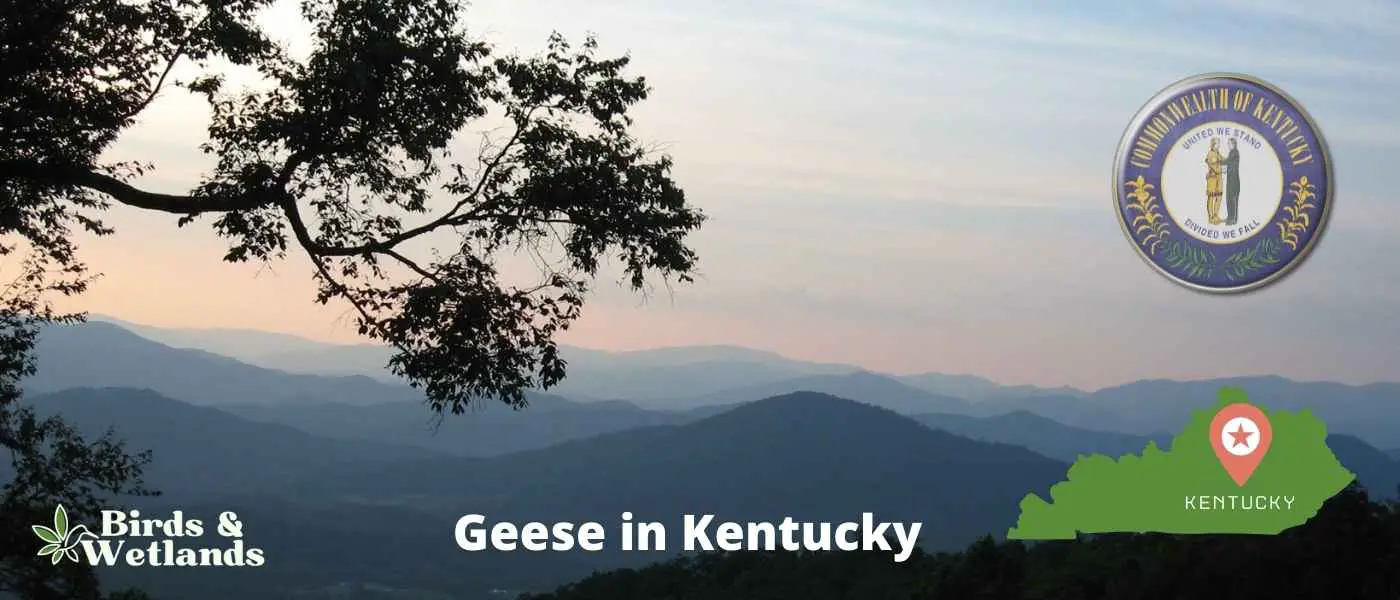Welcome to the verdant state of Kentucky, an ornithological wonder known for its remarkable array of geese. Whether you’re a seasoned bird watcher or a curious novice, exploring the presence of these fascinating waterfowl in the Bluegrass State is an adventure like no other.
With a multitude of habitats ranging from serene wetlands to bustling urban parks, Kentucky provides a nurturing home for both resident and migratory geese. Join us as we embark on this thrilling journey to uncover the five spectacular species of geese that grace the Kentucky landscape.
What Geese Are in Kentucky?
Kentucky is the home to 5 goose species and 2 swan species.
| Goose | Frequency in Kentucky | Resident Population | Specific Locations in Kentucky |
|---|---|---|---|
| Canada Goose | Common | Yes | Cave Run Lake, Land Between the Lakes National Recreation Area |
| Snow Goose | Seasonal (Winter, Spring migration) | No | Ballard Wildlife Management Area, Sloughs Wildlife Management Area |
| Ross’s Goose | Seasonal (Winter, Spring migration) | No | Peabody Wildlife Management Area, Lake Barkley |
| Cackling Goose | Seasonal (Winter, Spring migration) | No | Barren River Lake, Minor Clark Fish Hatchery |
| Greater White-fronted Goose | Seasonal (Winter, Spring migration) | No | Yatesville Lake, Green River Lake |
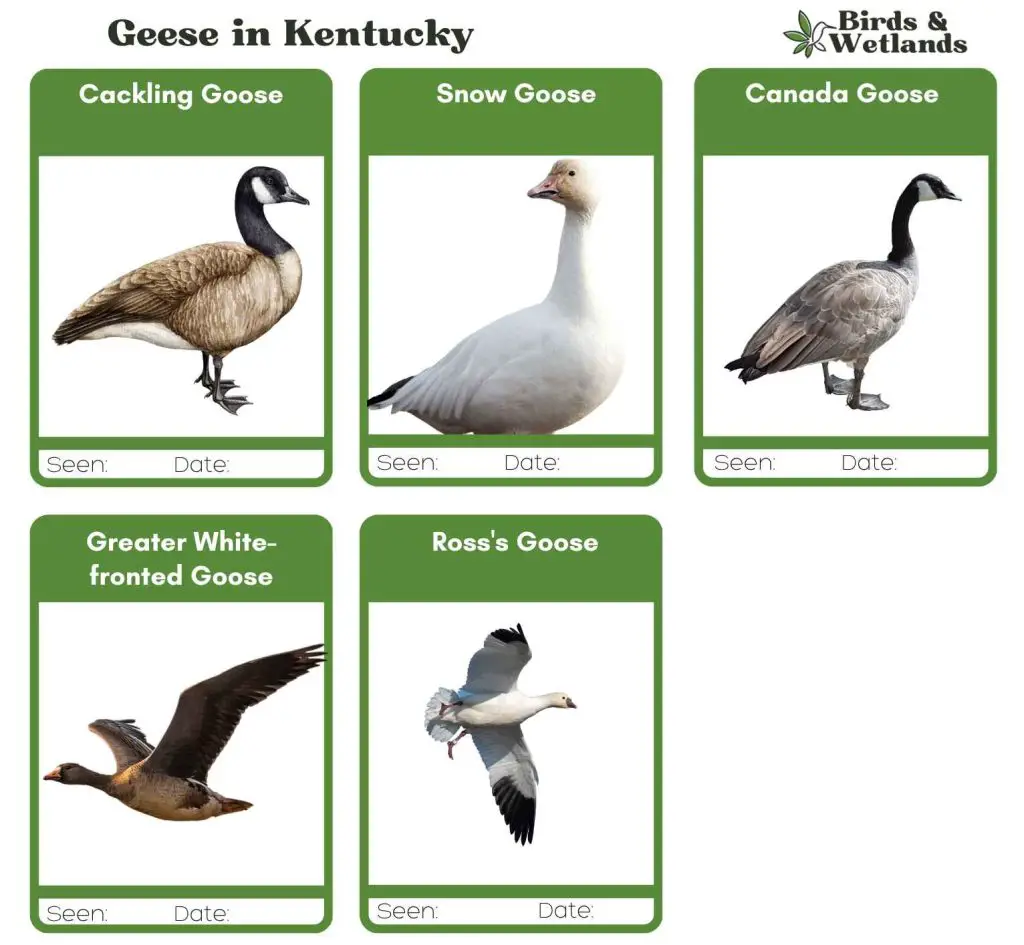
Geese Species Found in Kentucky
Canada Goose


Canada Goose Sound
Scientific Name: Branta canadensis
Length: 30 to 43 in
Wingspan: 50–73 in
Weight: 5.7–14.3 lb
The Canada Goose is a large, well-known species of waterfowl noted for its distinctive appearance, familiar “honk,” and migratory behavior.
Appearance: Both male and female Canada Geese have a similar appearance, featuring a black head and neck with distinctive white patches on the cheeks and chin. The body is primarily brown with a lighter, often white, underbelly.
Diet: Canada Geese primarily feed on plant matter, including grasses, aquatic vegetation, and grains. They can often be seen grazing in parks, lawns, and fields, as well as dabbling in water bodies.
Reproduction: Canada Geese typically nest on the ground near water bodies, often on islands or other isolated areas to avoid predators. The female lays a clutch of about 4 to 6 eggs, which she incubates alone for around a month.
Snow Goose

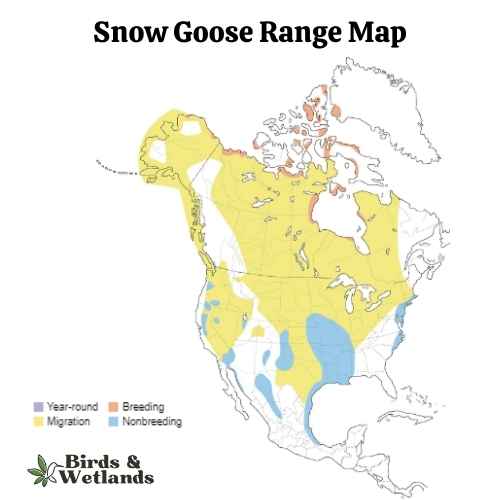
Snow Goose Sound
Scientific Name: Anser caerulescens
Length: 25 to 31 in
Wingspan: 53 to 65 in
Weight: 4.5 to 6.0
The Snow Goose is a large species of waterfowl known for its vibrant white plumage and significant migratory flights.
Appearance: True to their name, Snow Geese are predominantly white with black wingtips. They also have a pink bill, pink legs and feet. A color morph, known as the “Blue Goose,” displays a bluish-gray body with a white head, but is considered the same species.
Diet: Snow Geese primarily feed on plant matter, such as grasses, sedges, and small grains. They can often be seen in large flocks foraging in fields and marshes, and during migration and winter, they can cause considerable damage to agricultural fields due to their feeding habits.
Reproduction: Snow Geese typically nest on the tundra, near water bodies. The female builds the nest and lays a clutch of about 3 to 5 eggs, which she incubates alone for approximately three weeks. Once hatched, the goslings can feed themselves but stay with their parents for protection until they can fly.
Ross’s Goose
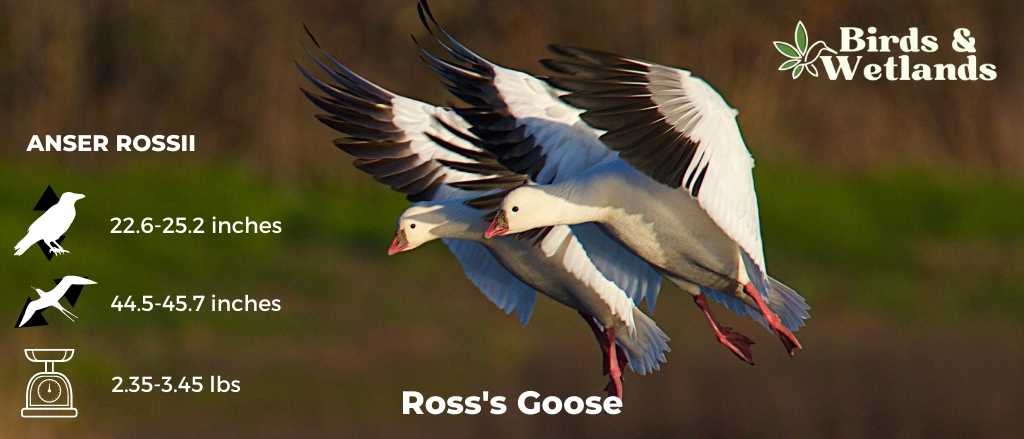
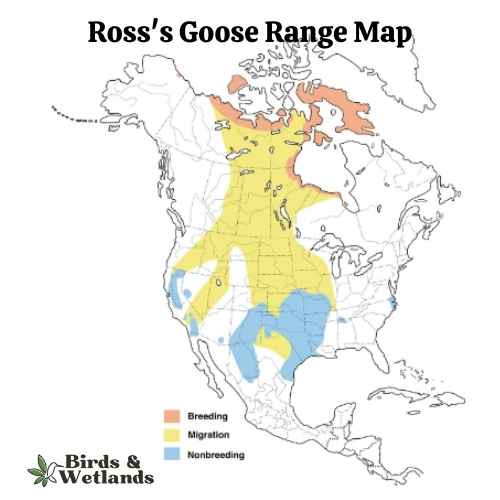
Listen
Scientific Name: Anser rossii
Length: 23.2-25.2
Wingspan: 44.5-45.7 in
Weight:42.3-55.3 oz
The Ross’s Goose is a small species of waterfowl often found in North America’s tundra and wetland habitats.
Appearance: Known for its compact size, the Ross’s Goose is mostly white with black wingtips. It features a short, stubby bill and a rounded head. One key identifying feature is the blueish gray base of its bill, which has a warty structure during the breeding season.
Diet: This goose feeds mainly on vegetation, including seeds, leaves, and roots of grasses and sedges. During winter and migration, they also consume grains and seeds from agricultural fields.
Reproduction: The Ross’s Goose nests on the ground, often in colonies. The female lays a clutch of 2 to 5 eggs which she incubates for around three weeks. The young geese, known as goslings, are precocial – they can walk, swim, and feed themselves shortly after hatching, although they stay with their parents until they learn to fly.
Cackling Goose
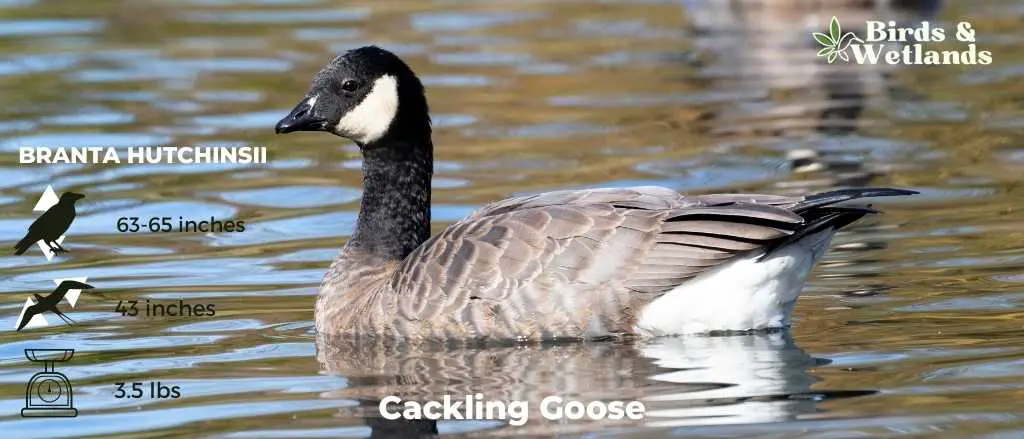
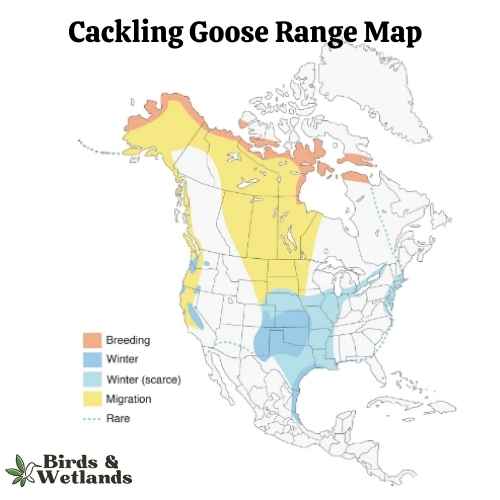
Listen
Scientific Name: Branta hutchinsii
Length: 24.8–25.6 in
Wingspan: 43-45.7 in
Weight:3.5 lbs
Cackling Geese are particularly known for their high-pitched, cackling calls, which is the source of their name. Despite their small size, these geese are renowned long-distance migrants, with some populations traveling thousands of miles between breeding and wintering grounds.
Appearance: With a similar color pattern to the larger Canada Goose, the Cackling Goose features a black head and neck, white chinstrap, light tan to cream chest, and brownish-grey body. One defining characteristic is its noticeably smaller size and stubbier neck compared to its larger counterparts.
Diet: Like many geese, the Cackling Goose’s diet mainly consists of plant matter. This includes grasses, seeds, and aquatic vegetation. They are often seen grazing on land or dabbling in shallow water.
Reproduction: Cackling Geese usually nest on the ground in elevated areas near water bodies, such as riverbanks or lakeshores. The female lays a clutch of 2 to 8 eggs and is responsible for incubation, while the male stands guard nearby. Incubation lasts for about a month.
Greater White-fronted Goose
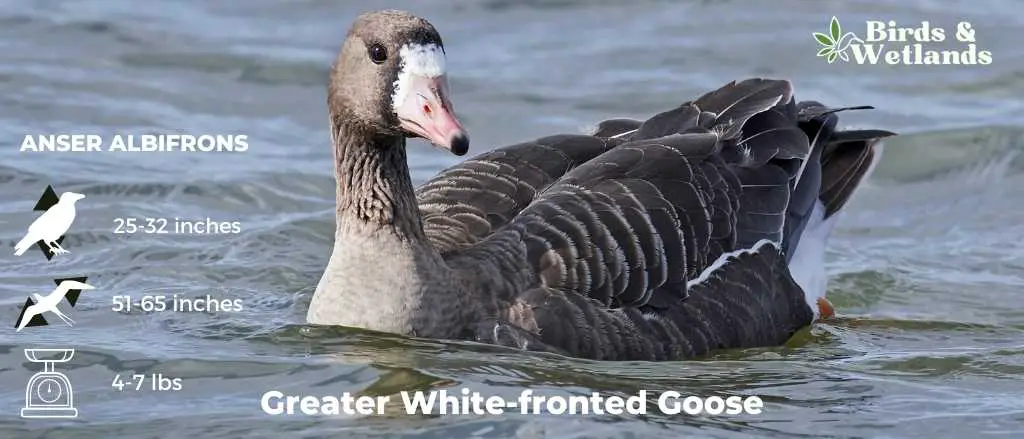

Listen
Scientific Name: Anser albifrons
Length: 25 to 31 in
Wingspan: 53 to 66 in
Weight: 3.3 to 6.6
The Greater White-fronted Goose is a medium to large waterfowl species, widely distributed across the Northern Hemisphere, particularly in North America.
Appearance: As the name suggests, these geese display a prominent white patch at the base of their bill. Their bodies are gray-brown, and their breasts are often marked with dark blotches. They possess a pinkish bill and orange legs and feet.
Diet: The Greater White-fronted Goose is a herbivore and feeds mainly on plant material. Its diet consists of grasses, sedges, grains, and berries. When wintering, these geese can often be found in agricultural fields, feasting on leftover grains and crops.
Reproduction: This species nests on the ground, often in areas with good visibility such as slopes or ridges. The female lays a clutch of 4 to 5 eggs, which she incubates for nearly a month. Once hatched, the young ones are taken care of by both parents until they are able to fly.
Where to Spot Kentucky’s Geese
Sloughs Wildlife Management Area: Located in Henderson County, this area provides a vast array of habitats that attract all sorts of waterfowl including various species of geese. It is well-known for its diverse and plentiful birdlife.
Barren River Lake State Resort Park: This state park in Lucas is a haven for waterfowl. With the park encompassing a large water body, it’s a fantastic place to see Canada Geese and other species in their natural habitat.
Lake Barkley: Near Cadiz, this large lake and its surrounding areas provide excellent conditions for geese. It is particularly popular during migration seasons.
Goose Pond Fish and Wildlife Area: Located in Greene County, this vast wetland area provides ample habitat for a diverse range of waterfowl species, including geese.
Minor Clark Fish Hatchery: Located near the Licking River in Rowan County, this hatchery provides a unique opportunity to see geese along with a variety of other bird species.
| Neighboring State | Best Spots to See Geese |
|---|---|
| Illinois Geese | 1. Emiquon National Wildlife Refuge 2. Chautauqua National Wildlife Refuge 3. Montrose Harbor in Chicago |
| Indiana Geese | 1. Eagle Creek Park, Indianapolis 2. Patoka River National Wildlife Refuge 3. Goose Pond Fish and Wildlife Area |
| Missouri Geese | 1. Loess Bluffs National Wildlife Refuge 2. Eagle Bluffs Conservation Area 3. Squaw Creek National Wildlife Refuge |
| Ohio Geese | 1. Ottawa National Wildlife Refuge 2. Hoover Reservoir in Westerville 3. Magee Marsh Wildlife Area |
| Tennessee Geese | 1. Reelfoot Lake 2. Great Smoky Mountains National Park 3. Radnor Lake State Park |
| Virginia Geese | 1. Chincoteague National Wildlife Refuge 2. Huntley Meadows Park 3. Back Bay National Wildlife Refuge |
| West Virginia Geese | 1. Ohio River Islands National Wildlife Refuge 2. Canaan Valley National Wildlife Refuge 3. Bluestone Wildlife Management Area |
In Central Kentucky and Western Kentucky, golf courses and farm ponds have become a preferred site for abundant populations of geese, leading to an increase in goose droppings and making goose control a priority.
Large lakes like Kentucky Lake and Lake Barkley, known for their wild and serene beauty, attract large numbers of permanent resident geese as well as migratory species such as Sandhill Cranes and even ducks like the wood duck. These bodies of water also provide a haven for the stunning Wood Ducks.
However, as fall turns into winter and snow cover increases, the availability of food may cause these wild geese to concentrate in the same areas as humans, with some even resorting to attacking people for food as they become permanent residents.
Notably, the Kentucky Department of Wildlife Resources is focused on managing these interactions and maintaining these natural habitats, including areas around the Barkley Dam.
Most people are fascinated by the spectacle of these birds, including the sight of their wings in flight and the texture of their feathers. Although geese are considered pest birds due to their large numbers and average weight (they are the largest birds), their presence remains a vital part of Kentucky’s diverse wildlife.
Are There Any Resident Flocks of Geese In Kentucky?
Canada geese are a familiar sight in Kentucky, where they can be found both in urban areas and in rural wildlife areas.
While Canada geese are not native to Kentucky, they have become well-established in the state, with a resident population of several thousand birds.
Hunting Geese in Kentucky
Hunting geese can be a great way to enjoy the outdoors and fill your freezer with delicious, healthy meat.
But before you head out into the field, it’s important to make sure that you’re complying with all state and federal regulations.
In Kentucky, anyone who wants to hunt geese must obtain a hunting license and a Kentucky Migratory Bird/Waterfowl Permit.
Can You Shoot a Goose in Kentucky?
Yes, you can shoot geese in Kentucky if you follow the regulations set forth by the U.S. Fish and Wildlife Service. One of those regulations is that you must use nontoxic shots no larger than size “T”.
Here’s the Kentucky daily bag and possession limit:
| Daily Bag | Possession | |
| September Canada Goose (all zones) | 5 | 15 |
| Canada/Cackling Goose, White-Fronted Goose & Brant | 5 combined; 3 Canada geese, 2 white-fronted geese and 1 brant | Triple the daily bag limit |
| Snow Goose (including Ross’ Goose) | 20 | none |
| Snow Goose Conservation Order | none | none |
Where Can I Hunt Geese in State?
Ballard WMA is a great place to hunt geese in Kentucky.
The area is known for its large concentrations of birds, making it a perfect spot for serious hunters. In addition, the terrain is relatively flat, making it easy to walk and set up decoys.
Is There a Goose Hunting Season in Kentucky?
Yes, the hunting season in Kentucky is usually from September to March.

